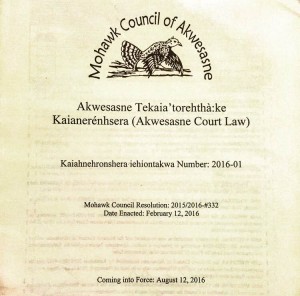Over the past months of my placement with the Mohawk Council of Akwesasne Justice Department, there have been some exciting legislative developments in the community. In June a referendum was held on the Akwesasne Oién:kwa Kaianerénhsera (Akwesasne Tobacco Law) regulating the manufacturing and distribution of tobacco on the territory,[1] and this month the community’s Tekaia’torehthà:ke Kaianerenhsera (Akwesasne Court Law) came into force.

I have decided to focus this blog post to the latter. The Akwesasne Court Law coming into force is an event worthy of celebration not only for the Mohawks of Akwesasne, but also for First Nations across Canada, because it marks the “birthday”[2] of the first ever independent court established by a First Nation.
Background
The Mohawks of Akwesasne have been administering their own justice since well before Jacques Cartier first arrived on Mohawk territory in 1535.[3] As members of the Haudenosaunee Confederacy, The Mohawks were united with the Cayuga, Onondaga, Oneida, Seneca, and later the Tuscarora, under the Kaianerekowa (Great Law of Peace); bringing together the previously warring nations. This law enforced the matrilineal clan system across the Confederacy, based on hereditary leadership.[4]
With Canadian Confederation, however, came a number of obstacles preventing the community from being able to effectively exercise their traditional Haudenosaunee government. Section 91(24) of the Constitution Act 1867 assigning “Indians and Lands Reserved for Indians”[5] to federal jurisdiction was used to justify a number of assimilative policies which had, and continue to have, severe repercussions for all First Nation communities, including Akwesasne.
In Akwesasne, elections were imposed by the Canadian government in 1899 in an attempt to disempower the traditional Mohawk council of chiefs.[6] This imposition, along with the larger assimilative scheme of the Canadian government, ultimately prevented the community from being able to administer their own traditional justice effectively.
Perhaps the greatest obstacle Akwesasne faced in this regard was the drawing of a Canadian-American international border squarely through their territory, and the further quartering of their land into the Canadian provinces of Ontario and Quebec. These borders alone have made it virtually impossible for the community to administer one cohesive justice system, since the Mohawk Territory of Akwesasne, and the larger Haudenesaunee Confederacy, now have to contend with multiple imposed colonial jurisdictions.
The Akwesasne Mohawk Court
Despite efforts to dispossess the Mohawks of their traditional institutions, the community has never stopped asserting their right to govern themselves and their traditional territory.[7] The Akwesasne Mohawk Court is an example of this.
The court itself, established by the Mohawk Council of Akwesasne (MCA), has existed since the 1970s, but its character has evolved substantially since then. For the first twenty or so years of existence, the court operated under the Indian Act, with Minster of Indian Affairs approved justices of the peace adjudicating by-laws passed under section 81 of the Act.[8] The court was therefore under tight control of the Canadian government.[9]
Over the past few decades, a number of interrelated factors made it easier for the community to effectively assert their right to make their own decisions about their judicial institutions.
Firstly, the Constitution Act 1982 entrenched this right by “recognizing and affirming existing Aboriginal […] rights”[10] under section 35(1) of the Act. This effectively gave the assertion of this right a Constitutional backbone. Furthermore, towards the end of the 1980s the Minister of Indian affairs began rejecting a greater number of by-laws proposed by the MCA. The band council ratified some of the rejected by-laws anyway, marking the beginning of the community passing legislation themselves under their inherent right, as opposed to under the authority of the Indian Act.[11]
An important factor leading to the establishment of an independent court at Akwesasne was a report produced by Bruno Steinke in 1995 (the Steinke Report). The findings of the report indicated that overwhelmingly Mohawks of Akwesasne were in favor of establishing their own independent Mohawk court on their territory. The survey indicated that the community wanted a court to be structured like a Canadian court, with the incorporation of traditional restorative Haudenosaunee principles, presided over by justices from their own community.[12]
A reading of the Akwesasne Court Law clearly demonstrates that the Akwesasne Mohawk Court as it stands today has been modelled directly from the Steinke Report recommendations. The law represents a significant shift from the Court’s earlier days of operation in one very important way: its source of authority is the community itself, and their inherent right to self-govern, as opposed to the Canadian government via the Indian Act.[13]
The Akwesasne Court Law
“This Akwesasne Tekaia’rorehthà:ke Kaianerénhsera (Akwesasne Court Law) reflects the values of the Mohawks of Akwesasne and the principles of Sken:en (peace), Kasatstensera (strength) and Kanikonri:io (a good mind), respect, fairness as well as natural justice.”[14]
The coming into force of the Akwesasne Court Law on August 12 laid a framework enabling the Mohawk Council of Akwesasne to adjudicate their community laws. The law sets out the principles, powers and authorities of the Akwesasne Mohawk Court and governs the conduct of the institution’s justices. It also outlines the Court’s jurisdiction, which spans across a broad range of civil matters, including contract disputes, matrimonial property, and the regulation of untaxed tobacco products on the territory.[15]
Aside from the symbolic significance of Akwesasne Court Law for Akwesasronon[16] in terms of what it means for the MCA’s assertion of self-government, the law also places the community at the forefront of indigenous self determination efforts in Canada by laying the foundation for the first independent court established by a First Nation.[17]
The mix of legal traditions informing the Court Law is also unique: In accordance with the expressed will of the community,[18] the court is set up to be adversarial; operating in accordance with fundamental principles of Canadian justice.[19] What sets it apart from Canadian courts is the incorporation of traditional restorative Mohawk principles into the institution’s judicial framework.
The distinct blend of traditions in the Akwesasne Court Law is particularly present in its sections pertaining to remedies. While some are in line with what one might expect a provincial or Federal judge to order, others are unique to the Mohawk Court. Illustrating the former, section 9.3 states the payment of fines or ordering injunctions are both within the scope of remedies a Mohawk judge might order.[20] On the other hand, the requirement under section 3.4 that a judge consider “the talents of the [offending party]”;[21] and use these for the benefit of the community to remedy their infraction; is a consideration one would certainly not encounter in a Canadian Court.
The inclusion of Mohawk principles in the Akwesasne Court Law is important for two reasons: Firstly, it is an affirmation of the community’s cultural identity. Secondly, by employing restorative mechanisms focussed on healing for offenders, the law illustrates an approach to justice which promotes the long term wellbeing of the community.
On a practical level, the Akwesasne Court Law guarantees members of the First Nation that their cases will be heard by a Mohawk Judge from their own community, and that they can choose to have court proceedings conducted in either English or Mohawk.[22] The law will also lessen congestion in nearby provincial courts, as it gives Mohawks of Akwesasne the possibility of referring to their own court to adjudicate community matters.
Concluding Thoughts
At the Akwesasne Justice Department I have been fortunate to work with some of the amazing trail-blazing minds behind the Akwesasne Court Law. I feel being an intern here during the first “birthday” of the Akwesasne Mohawk Court essentially gives me a backstage pass to history-in-the-making. Expressing how much this has meant to me is difficult, but suffice to say I consider myself to be one incredibly lucky law student (and human being).
You can find a digital copy of the Akwesasne Court Law, along with other community legislation on the Kaiahnehronsehra iehiontakwa (Akwesasne Law Registry):
http://www.akwesasne.ca/lawregistry
[1] Akwesasne Oién:kwa Kaianerénhsera (Akwesasne Tobacco Law), MCR 2016-2017-#075, Purpose para 2.
[2] Credit to Gilbert Terrance, Court Administrator, who called August 12th “the Birthday of the [Akwesasne Mohawk] Court.”
[3] Frey, S.L., The Mohawks : An Inquiry Into their Origin, Migrations and Influence Upon the White Settlers, (Utica: Oneida Historical Society, 1898) at p 6.
[4] Joyce Tekahnawiiaks King, “The Value of Water and the Meaning of Water for the Native Americans Known as the Haudenesaunee” (2007) 16:3 Cornell Journal of Law and Public Policy 1.
[5] Constitution Act, 1867 (UK), 30 & 31 Vict, c 3, s 91(24) , reprinted in RSC 1985, Appendix II, No. 5.
[6] Rarihokwats, How democracy came to St. Regis & the thunderwater movement, (Rooseveltown, NY: Akwesasne Notes, 1974) at p 8.
[7] Ibid at p 3.
[8] Indian Act, RSC 1985 c I-5.
[9] Anna Gilmer in conjunction with the Akwesasne Justice Department, History of the Akwesasne Mohawk Court (2015) at p 6 [unpublished, archived at the Mohawk Council of Akwesasne Justice Department].
[10] Constitution Act, 1982, being Schedule B to the Canada Act 1982 (UK), 1982, c 11.
[11] Ibid note 6 at pp 8-9..
[12] Bruno Steinke, “Justice Needs in a Mohawk Community: Akwesasne” August 1995 at pp 65-70.
[13] Akwesasne Tekaia’torehthà:ke Kaianerénhsera (Akwesasne Court Law), MCR 332 2016, Preamble para. 10.
[14] Ibid at Purpose para 2.
[15] Ibid at ss 5.1-5.4
[16] “Akwesasronon” is the Mohawk term for community members of Akwesasne.
[17] While other First Nations have established courts (see the Nisga’a Treaty), the Akwesasne Mohawk Court is the first institution of its kind established under the inherent Aboriginal right to self-government, recognized and affirmed by section 35 of the Constitution Act, 1982.
[18] Ibid note 9.
[19] For example, section 7 of the law helps to ensure the principle of judicial independence is upheld by holding the Akwesasne ratiianerenhserakweniénhstha (justices) and teshatiia’toréhtha (appeal justices) accountable to the Akwesasne Review Commission for their conduct. The Akwesasne Review Commission can also be called upon to rule on an alleged conflicts of interest of justices or appeal justices.
[20] Ibid note 13.
[21] Ibid.

